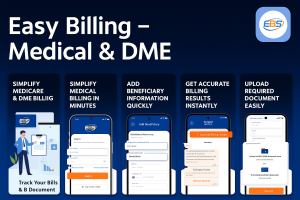Running a chiropractic practice comes with its fair share of challenges, one of the most significant being the complexity of billing. Chiropractic billing involves numerous codes, insurance regulations, and payment procedures that can be overwhelming if not managed efficiently. Streamlining your chiropractic billing process not only ensures timely payments but also helps you avoid costly mistakes and reduces the risk of claim denials.
In this blog post, we’ll share practical tips and strategies that can help you improve your chiropractic billing efficiency and reduce administrative burdens, allowing you to focus more on providing quality care to your patients.
1. Implement a Reliable Chiropractic Billing Software System
One of the first steps to improving your chiropractic billing efficiency is adopting an integrated billing software system. A reliable software system can significantly reduce human error and ensure that your claims are accurately coded and processed.
Why Invest in Chiropractic Billing Software?
- Simplifies Claim Submissions: With integrated software, claims can be submitted electronically, reducing the chances of errors compared to manual submissions.
- Automates Coding: Billing software often includes built-in coding tools that automatically generate appropriate codes based on the services provided during a chiropractic visit.
- Tracks Payments: Modern chiropractic billing software systems track payments and follow up on unpaid claims, ensuring that your practice receives payment in a timely manner.
Actionable Tip: When selecting a billing software, choose one that integrates with your practice management system and supports all the necessary insurance providers. This will help streamline the billing process further.
2. Stay Updated on Coding Changes
Chiropractic billing involves several codes, including Current Procedural Terminology (CPT) codes, International Classification of Diseases (ICD-10) codes, and Healthcare Common Procedure Coding System (HCPCS) codes. As insurance policies and healthcare regulations continue to evolve, staying up to date on changes in these codes is essential for accurate billing.
What You Need to Know:
- CPT Codes: These codes are used to describe the procedures performed during a chiropractic visit, such as spinal manipulation, diagnostic tests, or therapeutic exercises.
- ICD-10 Codes: These codes indicate the diagnosis or condition being treated. Accurate ICD-10 codes are critical to justify the treatment and ensure proper reimbursement.
- Modifiers: These are used to indicate specific circumstances for billing, such as additional services provided or changes in a patient’s condition.
Actionable Tip: Regularly attend coding webinars and subscribe to coding newsletters to keep up with the latest updates. You can also work with a certified coding professional to ensure accuracy.
3. Ensure Accurate Patient Information
Accurate patient information is the foundation of an efficient billing process. Billing errors often occur due to incomplete or incorrect patient data, such as incorrect insurance details, billing address, or date of birth.
Steps to Ensure Accuracy:
- Verify Insurance Information: Always verify the patient’s insurance coverage before their appointment. Ensure that the coverage includes chiropractic care, as not all insurance plans cover chiropractic services.
- Confirm Patient Details: Double-check personal information, including name, address, and phone number. Mismatched data can delay the payment process or result in claim denials.
- Collect Co-Payments: Make it a standard practice to collect co-payments at the time of service. This prevents delays and reduces the chance of payment issues down the road.
Actionable Tip: Use an automated eligibility verification tool within your billing software to confirm insurance details before the patient visit. This can save time and avoid claim rejections.
4. Streamline Your Claim Submission Process
One of the most time-consuming aspects of chiropractic billing is the claim submission process. Submitting claims manually or via paper can result in delays, increased administrative costs, and more opportunities for errors. Switching to electronic claims submission can streamline the process and reduce the risk of mistakes.
Why Switch to Electronic Claims Submission?
- Faster Processing: Electronic claims are processed faster, meaning you’ll get paid sooner. This also reduces the need for follow-ups and minimizes delays.
- Lower Error Rate: Electronic submission reduces human error, especially when coding is automatically populated within your billing software.
- Real-Time Updates: Electronic submission allows you to receive real-time updates on claim status, so you know immediately if there are any issues or denials.
Actionable Tip: Make sure your practice management software is integrated with the Electronic Data Interchange (EDI) system to enable seamless electronic claim submissions.
5. Regularly Review and Follow Up on Claims
Even after you submit a claim, the job isn’t done. Claims can often be delayed, denied, or underpaid. Regular follow-ups ensure that these claims are being processed correctly and that you’re getting paid what you’re owed.
Steps to Take:
- Track Claim Status: Use your billing software to track the status of each claim. Many software systems offer real-time updates on the claim process, making it easier to manage.
- Address Denials Promptly: If a claim is denied, don’t wait to resolve the issue. Denied claims often result from missing information, coding errors, or insurance discrepancies.
- Appeal When Necessary: If the claim denial is unjustified, be prepared to file an appeal with the payer, providing any additional information needed to support your claim.
Actionable Tip: Designate a team member or hire a billing specialist to follow up on unpaid claims and denials to ensure timely resolution.
6. Invest in Staff Training and Continuing Education
Billing errors are often the result of insufficient training or outdated knowledge. Investing in ongoing education for your billing team can pay off by ensuring that they understand the latest codes, regulations, and best practices in chiropractic billing.
Training Topics:
- Code Changes and Updates: Ensure that your billing team is familiar with any recent changes in CPT, ICD-10, and HCPCS codes.
- Billing Best Practices: Educate staff on proper documentation practices, timely claim submission, and how to handle rejected claims.
- Insurance Requirements: Make sure your team is aware of each payer’s specific billing requirements, including which services are covered and any restrictions.
Actionable Tip: Offer quarterly or bi-annual training for your billing staff to ensure they stay up to date on the latest billing procedures.
7. Improve Documentation Practice
Good documentation is critical for successful chiropractic billing. Not only does it serve as the foundation for the services you bill for, but it also acts as evidence that can support your claims if they are ever audited.
What Should You Document?
- Patient Visit Details: Record the specifics of each treatment, including any spinal manipulations, therapeutic exercises, or other chiropractic services.
- ICD-10 Codes: Accurately document the diagnosis and link it to the appropriate ICD-10 code to justify the treatment provided.
- Treatment Progress: Keep track of the patient’s progress with detailed notes that show the medical necessity of continued treatment.
Actionable Tip: Encourage chiropractors and staff to use digital documentation tools that integrate with your billing software. This makes it easier to track and retrieve the necessary information for claims.
8. Focus on Compliance
Chiropractic billing is subject to a wide range of regulations, including state-specific guidelines, payer rules, and federal healthcare regulations. Failing to comply with these regulations can result in fines, audits, and a loss of reputation.
How to Stay Compliant:
- Know Your Payers’ Requirements: Every insurance company has different rules for billing. Be sure to stay on top of each payer’s guidelines.
- Audit Your Billing Regularly: Periodically review your billing processes and claims to ensure that you’re following all regulations and identifying potential compliance issues.
- Stay Up-to-Date with State and Federal Regulations: Chiropractic billing is regulated by both state and federal agencies, so it’s essential to stay current with the latest healthcare laws.
Actionable Tip: Set up regular internal audits and work with a compliance expert to ensure your practice is following all necessary billing regulations.
Conclusion
Improving your chiropractic billing efficiency involves a combination of streamlined systems, continuous education, and proactive management. By implementing the tips outlined in this post, you’ll reduce errors, speed up your payment cycle, and improve overall practice efficiency. From investing in reliable billing software to staying up to date with coding and insurance regulations, every step you take can help reduce the administrative burden and optimize your billing process.
If you need expert help with your chiropractic billing or have any questions about implementing these best practices, don’t hesitate to contact us today. Let us assist you in achieving a more efficient, accurate, and compliant billing process. Ready to improve your chiropractic billing efficiency? Contact us now!









